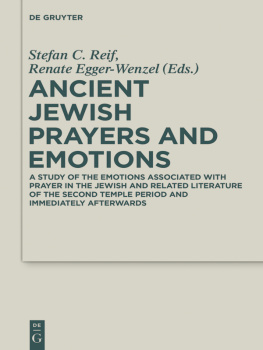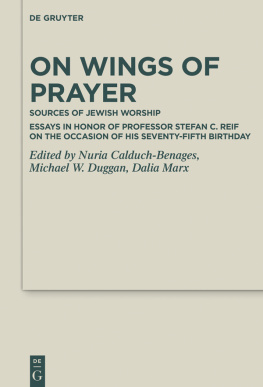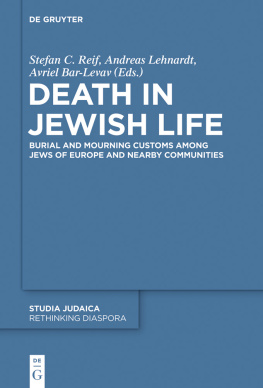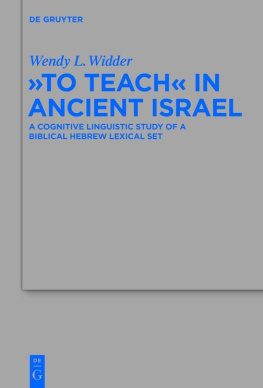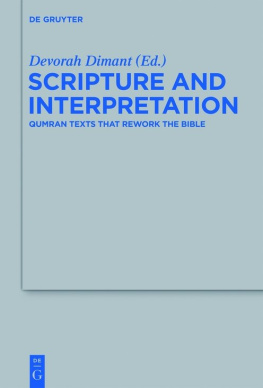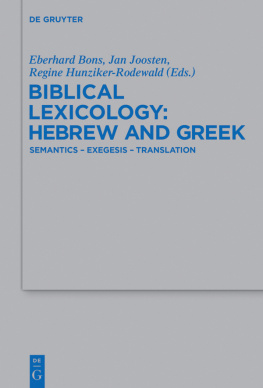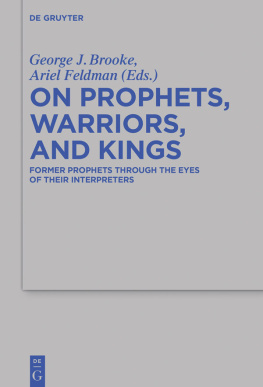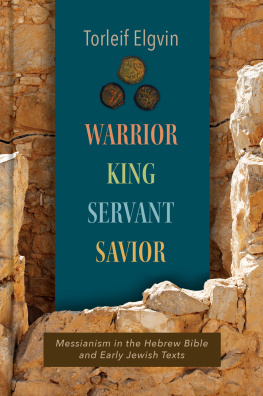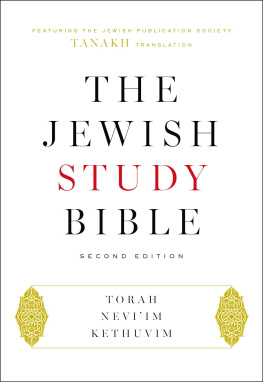Table of Contents
Guide

Stefan C. Reif
Jews, Bible and Prayer
Beihefte zur Zeitschrift fr die alttestamentliche Wissenschaft

Edited by
John Barton, Reinhard G. Kratz, Nathan MacDonald,
Carol A. Newsom and Markus Witte
Volume 498

ISBN 978-3-11-048436-6
e-ISBN (PDF) 978-3-11-048670-4
e-ISBN (EPUB) 978-3-11-048585-1
ISSN 0934-2575
Library of Congress Cataloging-in-Publication Data
A CIP catalog record for this book has been applied for at the Library of Congress.
Bibliographic information published by the Deutsche Nationalbibliothek
The Deutsche Nationalbibliothek lists this publication in the Deutsche Nationalbibliografie; detailed bibliographic data are available on the Internet at http://dnb.dnb.de.
2017 Walter de Gruyter GmbH, Berlin/Boston
www.degruyter.com

For Renate
she and I both know why
Introduction
In the course of the past two decades, most of the articles that I have contributed to anthologies, to conference proceedings and to Festschriften have centred on the themes of the Cairo Genizah, the rabbinic exegesis of the Hebrew Bible, and the development of Jewish liturgy. It is in the nature of such contributions that they are rarely provided with the opportunity of being compared with each other, or of attracting the attention of readers who are neither contributors nor honorands. As a consequence, the scholarly suppositions that underlie their composition, and the conclusions that derive from the analysis of the sources that they contain, are often neither carefully assessed nor evaluated more broadly. Such assessment and evaluation might raise new issues, tackle old ones in a fresh way, and even stimulate specialists and readers with wider interests to examine topics not previously part of their intellectual agenda.
I therefore warmly welcome the kind invitation extended to me by the editors of the Beihefte zur Zeitschrift fr die alttestamentliche Wissenschaft ( BZAW ), and their publishers, Walter de Gruyter, to compile a volume containing a selection of my recent articles, as well as one lengthy new one. It not only allows me to make some minor revisions and updates in these items but also to offer some introductory remarks about my motivations and conclusions. Bringing them together and prefacing them in this way may help to ensure that they are rescued from what otherwise might become a dusty fate on the dark and rarely consulted shelves of a few distinguished research libraries. Given current trends in some circles towards reducing, moving or even abandoning hard copies of these kinds of publications, such a fate might not be the worst prospect to be faced by scholarly materials of this sort. Let me therefore suggest why I believe that the essays included here may repay a close read on the part of specialists, as well as those with a more general interest in these topics.
I commence with the more personal and less clinical of my concerns. Whether or not this is indicative of the aging process, I have in recent years extended my enthusiasm for the study of medieval manuscripts, commentaries and liturgies to include a more intense appreciation of those personalities who have preceded me in such recondite pursuits. It has often proved intriguing at least to me to uncover the motivations for their involvement in specific aspects of research, the manner in which they undertook their projects, and the nature of the relationships that they enjoyed (if that is the correct word) with their colleagues and competitors. For the purist proponents of the Wissenschaft des Judentums , some of whom were among my most inspiring teachers, such a preoccupation with the purveyors of scholarship, rather than, or even in addition to, the scientific materials that they delivered, was nothing short of anathema. They held strongly to the view that their findings were to be judged on academic merit alone, without reference to the background, education and personal traits of those presenting them.
Perhaps it was the human story, or collections of human stories, that lay behind the discovery, exploitation and publication of the literary and documentary treasures from the Cairo Genizah, that set me on this path. Be that as it may, I found myself progressively less able to deal with detailed aspects of research topics without relating, at least in some degree, to the individuals who had, in one way or another, undertaken the pioneering work that had inspired their emergence. I tried to trace the efforts of such individuals in my studies of the Cambridge Genizah Collections, as well as in articles concerning the early examination of such items as the Ben Sira fragments and the Damascus Document. Readers of the current volume will find that I commence the first chapter with a quotation from the late and lamented doyen of Jewish historians, Jacob Katz, as to how he viewed such personalization of higher learning. Despite his horror at what he termed such a chutzpa, I proceeded to examine how Schechter and his contemporaries dealt with one of the most exciting Genizah finds of their day and with the contentious relationships that existed between those who were involved or were denied involvement in its description and analysis.
There are also some personal elements in the next seven essays presented here. These latter deal primarily with the Jewish interpretation of the Hebrew Bible in a broad berblick ; offer examples of such exegesis as it occurs in the case of four specific biblical chapters; and finally examine the wide-ranging and evolving senses of three Biblical Hebrew expressions. I shall shortly have more to say about the approach that characterizes these essays. Meanwhile, it seems appropriate to point out why I have not omitted here the remarks I originally made in some of them about the individuals in whose honour the contributions were originally made.
Demonstrating again my recent interest in the role of human stories within the larger scholarly context, I have prefaced essays written in the Festschriften offered to the late Shelomo Morag and John Emerton, and in honour of my contemporaries, Andrew Macintosh and Robert Gordon, by recalling at least some of the ways in which we connected during our lengthy academic careers. Such reminiscences are often included in the original oral presentation of a paper but omitted at the published stage. I think this is a pity, since they may well then be lost forever. When, many decades from now, what we have written on a scholarly topic might have been superseded by more fashionable and alternatively researched work, it is possible that what we have had to say about fellow scholars may remain of value. In the case of what I have had to say about my colleagues, it is perhaps not immodest to hope that it will be relevant for those historians who ultimately come to write the history ( Wissenschaftsgeschichte ) of Hebrew and Jewish scholarship at the University of Cambridge in the second half of the twentieth century and in the first two decades of the twenty-first.
What then were the motivations for my essays on the Jewish interpretation of some chapters of the Hebrew Bible? It seemed to me that the nineteenth-century study of the Hebrew Bible had been dominated by some distinguished Christian scholars who had made an outstanding contribution to the field but had often suffered from two shortcomings. Firstly, they seemed unaware of the theological tendenz that sometimes affected (or infected?) their analysis and conclusions. It is perhaps inevitable that religious commitments should have an impact on ones work on sacred texts but a genuine scholar is surely duty-bound to be aware of these and to make a maximum effort to minimize them. Such an effort was lacking on the part of a number of Christian hebraists who made a mark on the subject but also therefore left an imprint of their religious bias. Secondly, there was in that classical period of biblical criticism a hesitation about the use of rabbinic sources for the clarification of biblical topics. There were perhaps a number of reasons for this. They may well have lacked the competence to deal with such sources or lacked sympathy for their contents. In addition, they often subscribed to the notion that valuable culture was to be found in the Greek and Roman worlds, and then again after the Renaissance and Reformation. The period between was that of the dark ages and anything medieval came to be regarded as outdated, irrelevant, even primitive. I should add that the Christian scholars who adopted such an approach were sometimes no more enthusiastic about pre-modern Christian scholasticism than they were about its Islamic and Jewish counterparts. It has to be acknowledged that there were Christian scholars such as S. R. Driver who were innocent of such trends but there is no doubt that Old Testament studies of the twentieth and twenty-first centuries did not wholly free themselves from the shortcomings just described.


